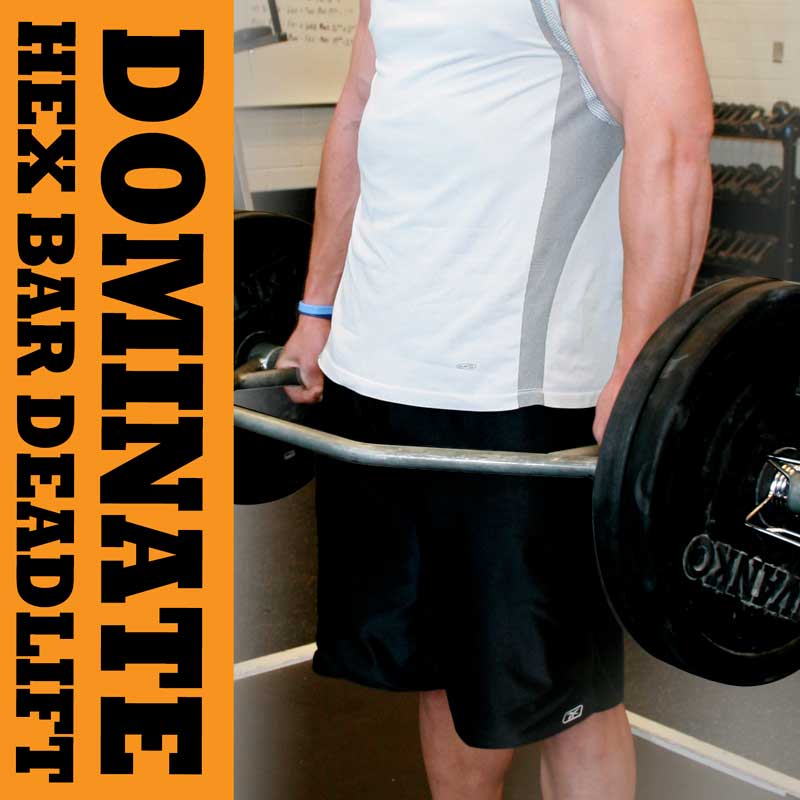Dominate with the Hex Bar Deadlift!

When BFS began doing clinics over 40 years ago, we taught that the three power lifts, along with the power clean, were key to success in a unified program. We still believe that, but with one change – we found that the hex bar deadlift is superior to the straight bar deadlift. Not only for athletic performance but also for general physical fitness.
First, let’s not confuse a hex bar with a trap bar, which was developed over three decades ago by Al Gerard, a powerlifter from North Carolina who deadlifted 625 pounds in his 40s. Gerard designed the trap bar to help him to continue to lift heavy weights off the floor with less stress on his lower back.

The trap bar had a triangle shape and had parallel grips attached to the sides. To use it you stand in the center of the triangle and grasp the handles so that the center of the barbell is positioned in line with your hips, which is your center of mass. At BFS, we refer to this optimal position of balance as the power line.
In contrast to the trap bar, with a straight barbell, the resistance is positioned forward of the body’s center of mass. This difference in body position requires more effort from the posterior chain muscles (glutes, hamstrings, and erector spinae muscles of the lower back) to maintain optimal technique.
The September 1986 issue of Powerlifting USA magazine featured the first advertisement for Gerard’s trap bar, shortly after which BFS began selling it and promoting its use in clinics. In addition to deadlifting, the trap bar proved to be a superior way to perform shoulder shrugs. To get more bang for your buck, before returning the trap bar to the ground, BFS recommended finishing the last set of deadlifts by performing several reps of shoulder shoulders. In 1992, Paul Kelso wrote a classic book on this subject, Kelso’s Shrug Book, that promotes the use of the trap bar for shoulder shrugs.
For reasons that are beyond the scope of this article, production of the trap bar was temporarily stopped in the early 2000s. It was at this time that another company thought that a hexagon design would be better than a triangle. It was! This design proved superior because there was more leg room and it was easier to balance.
To perform the deadlift with the hex bar, the step into the center of the hexagon and assume the BFS jump stance (feet shoulder with apart). Squat down and grab the handgrips on both sides of the bar. Rather than having the hands placed exactly in the middle of the handle, offset your grip about ½ inch – this will help prevent it from tilting. Now spread the chest (to lock the lower back in place), and keep the head up with eyes forward (on target), and stretch the chin away from the chest. Keeping the knees directly over the feet, lift the bar straight up through the power line, gradually decreasing the angle of the torso until you are upright.
Once you have stood up completely, the first repetition is finished and you are ready for the next rep. Now proceed to squat back down, again keeping the lower back locked in, chest spread, and eyes forward. Maintain tension in your core muscles by using a touch-and-go technique when the bar touches the floor; don’t bang it off the floor, but bounce it slightly (using bumper plates will make this transition smoother).
For youth, beginners and lighter athletes these 15-pound bars Hex Bars and Straight Bars can make the transition to increased weight much safer by allowing the lifter to keep proper form and technique through a smooth incremental progression
Please understand that BFS does not consider the straight bar deadlift a bad exercise, and we recommend performing it if a gym doesn’t have hex bars. But BFS-trained coaches have found that in working with countless athletes and looking at the research conducted on this lift, the hex bar has several advantages over the straight bar. Here are seven of them.
1. It’s Easier to Teach. With the hex bar, the hands are positioned at the sides of the body, making it easier to maintain a neutral spine. With a straight bar, the bar is positioned in front of the body, and this mechanical disadvantage makes it more likely that those performing it will round their back, placing the spine at a high risk of injury.
2. Superior for Developing Power. The hex bar is superior to the straight bar for developing power, which can be defined as the ability to display strength quickly. In a study published in the May 2016 issue of the Journal of Strength and Conditioning Research, the authors expanded on this opinion, explaining that “the hexagonal barbell may be more effective at developing maximal force, power, and velocity.”
3. Develops Core Stability. The Farmer’s walk involves carrying two large cylinders for distance, but it can also be performed with a hex bar as the handles are positioned alongside the body. And with the hands positioned a few inches away from the body, there is little risk of the edges banding against the thighs.
Although the vertebrae of the spine respond well to flexion, extension and lateral side bending, twisting motions can easily tear the rings of fibrous connective tissue that surround the discs and thereby lead to early degenerative disc disease. For this reason, athletes (and the general population) are advised to regularly perform some type of core training. In a study on strongman training published in the July 2009 issue of the Journal of Strength and Conditioning Research, researchers confirmed what the Iron Game community already knew. They concluded that strongman exercises such as the farmer’s walk can “…clearly challenge the strength of the body linkage, together with the stabilizing system, in a different way than traditional approaches.”
4. Fits Taller Athletes. Especially tall athletes often have a difficult time performing straight bar deadlifts as they have to bend their legs more than shorter athletes. The result is that they are more likely to round their lower back. The solution is the high hex bar. They are identical except the high Hex bar has elevated handgrips. The higher starting position allowed by the high hex bar makes executing exercises easier for tall athletes because they won’t need to bend their knees as much as with a regular hex bar.
Although some programs have both regular and high Hex bars, for those with limited space BFS offers combo hex bars. By simply flipping the bar over, you can perform either the regular hex or the high hex. If you have a small weight room a few bucks, the combo hex bar is the best choice.
5. Works the Quads Harder. The more upright position used in the hex bar deadlift increases the stress on the quadriceps, compared to a straight bar deadlift. In this sense, the hex bar deadlift should be considered a flexor exercise, whereas the straight bar deadlift is more of an extensor exercise.
6. Places Less Stress on the Spine. As Gerard’s pioneering research proved, trap bars and hex bars are easier on the spine. A study confirming this effect was published in the July 2011 issue of the Journal of Strength and Conditioning Research. The researchers concluded the following, “For individuals with lower-back injuries or pain, the results of this study suggest that the hexagonal barbell may be the better choice for barbell selection because of its ability to evenly distribute the load among all joints and reduce the moment at the lumbar spine.”
7. Increases Jumping Ability. The hex bar is a superior method of performing not just deadlifts, but also squat jumps; this, in turn, produces superior jumping ability. A study confirming this was called, “Effect of Load Positioning on the Kinematics and Kinetics of Weighted Vertical Jumps,” and it was published in the April 2012 issue of the Journal of Strength and Conditioning Research.
As with all BFS core lifts, it’s important to keep records and set goals. For male athletes, the BFS Varsity Standard for the Hex bar deadlift is 400 pounds, the All-State Standard is 500 pounds, and the All-American Standard is 600 pounds. Female athletes have a Varsity Standard of 235, an All-State Standard of 325, and an All-American Standard of 415.
Because the hex bar has become so popular, we found that heavier weights were being used. For this reason, heavier hex bars have been developed, the first of which weighed 75 pounds. This bar has longer sleeves and as such much heavier weights can be used. On the other extreme, there are also youth hex bars available that weigh only 15 pounds. The lighter weight enables young athletes in the Readiness stage of the BFS program, or just graduating from this program, to be able to use it.
Although athletes and the general fitness community got away from doing conventional and hex bar deadlifts in favor of other exercises, we have seen a resurgence in the popularity of the lift. To be clear, there is no question that the straight bar deadlift is superior total body exercise. However, based upon our experienced and the results of current research, some shared in this article, BFS believes that the hex bar deadlift is just a bit better.
